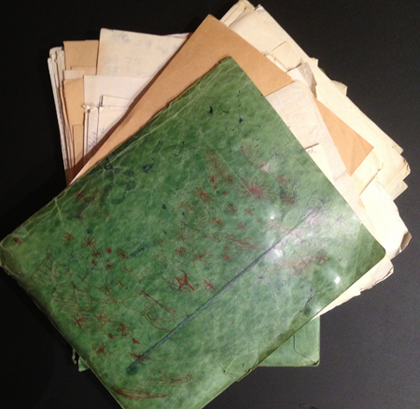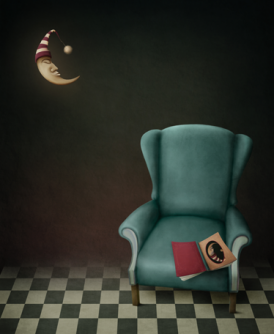Growing a Piece of Writing
For the past few weeks, this has involved falling back into a particular year or two in the early seventies, reading personal letters and diaries from that era, looking at photographs, remembering. Recently I looked into the green folder, the one that holds the writing I did when I was in high school—the drafts of poems and narratives and letters, mostly poems, many of them containing the sentiment one might expect of a teenage girl, odes to love and friendship, some of them transcending sentiment, striving to express the ineffable.

The green folder is so old and stuffed with drafts from my teenage years that it’s split open at the spine. When I wasn’t filling the folder with my writing, I was doodling on the outside of the folder, here with a red pen. Photo by me.
I remember now that that’s how I always felt about the green folder, even when I was creating the work. Because the pieces are unassembled, there’s a sense of disarray among the finished and the unfinished, the half-developed thought and the completed story, the image that fell flat and the song that’s lovely and lyrical, the pages of rhymes and the pages of self-inquiry. The green folder contains chaos and creativity. It invites me to discover.
I’m happy to have rediscovered the teenage writer in me. In those days I didn’t know I was a writer, but I knew I loved to write, and looking back I can see that that was pretty much all I needed to build my life around writing.
Go on a scavenger hunt through your old files—letters, photos, school papers, pieces you wrote for fun. How would you describe your earliest work? How does your early writing connect with the writing you’re doing today?


Funny, I’ve been thinking about my “green folder” lately—for me, a marble composition book and a blue folder filled with three-hole, wide-ruled paper covered with my trademark fountain-pen scribbles. I went through some of it a couple of years ago and have been longing recently to do it again. One aspect that interests me in particular is how much more freely I shared my work then, compared to now. How do I recapture the fearlessness of my teenage writing self, when I didn’t worry how or if people judged my writing, because all I was trying to do then was express my thoughts and feelings?
Hi, EC Writer. I’ve had the opposite experience lately: I’ve been reading my work to friends soon after I write it. This is very unlike me. Maybe keeping this blog is giving me the courage to go public … or maybe I need a writing group … or maybe it’s time to start sending my short pieces out. It’s been a long time since I submitted my work.
Here’s the thing: There is a sense of “submitting” when you give your work-in-progress to someone else. It’s literally out of your hands. You have no control over their response. And that’s scary. I think it’s important to choose readers carefully, to ask for the kind of feedback you want, and to give yourself permission to reject feedback that’s not helpful or that doesn’t resonate.
My friend Barbara Rockman says that film critic Roger Ebert used to ask himself after viewing a film, “What happened to me?” In her writing group they ask, “How did this poem make me feel?” What a generous, compassionate way to read and respond!
In “Thoughts on Making a Book,” Barbara talks about how she came to terms with feedback she received on the subject of her work.
I have a hunch that the fearlessness of your teenage writing self is still with you. Check in with her and see what she has to say about this.